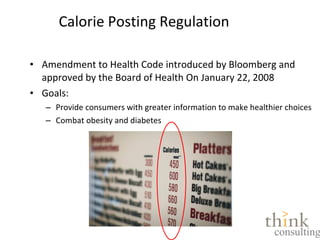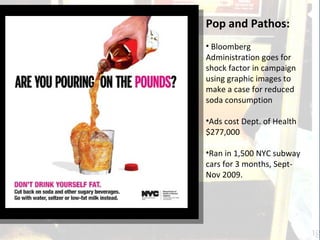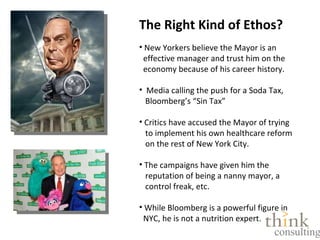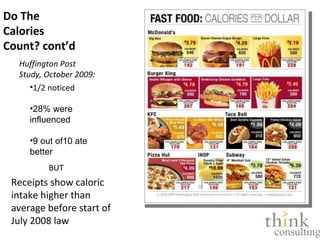2deckbloomberg
- 1. Food Wars Truth and Persuasion:
- 2. Which of these foods would you consider to be less healthy based on calorie and fat content? You tell us:
- 3. Grilled Chicken Caesar Salad 9 oz. Filet Steak Outback Steakhouse OR
- 4. Dunkin Donuts Plain Bagel with Cream Cheese Chocolate Glazed Cake Donut OR
- 5. Olive Garden Cheese Ravioli with Meat Sauce Garlic-Herb Chicken with Broccoli OR
- 6. Starbucks Grande Light Caffé Vanilla Frappuccino Grande Orange Mango Banana Vivanno Smoothie OR
- 7. Why would most people choose the wrong food in this game? We are predisposed to believe that certain foods are healthier than others Common sense tells us that we are better off eating salads than steaks, bagels than donuts, etc.
- 8. Calorie Posting Regulation Amendment to Health Code introduced by Bloomberg and approved by the Board of Health On January 22, 2008 Goals: Provide consumers with greater information to make healthier choices Combat obesity and diabetes
- 9. Use of Logos Nearly 33 % of children/adolescents and 65% of adults in the United States are overweight or obese Obesity costs the country more than $117 billion per year in direct medical expenses and indirect costs (reduced productivity, etc.) Lower calorie diets prevent obesity and diabetes Based on idea that when people have calorie information they use it ¾ of consumers say they look at calorie information on packaged foods in supermarkets ½ say nutrition information affects their food selections ( http://home2.nyc.gov/html/doh/html/pr2008/pr023-08.shtml )
- 10. Pop and Pathos: Bloomberg Administration goes for shock factor in campaign using graphic images to make a case for reduced soda consumption Ads cost Dept. of Health $277,000 Ran in 1,500 NYC subway cars for 3 months, Sept- Nov 2009.
- 11. “ The average American consumes about 35 gallons of non- diet soda each year and gets far more added sugar from soda than from desserts.” -Nicholas Kristof , New York Times 12/17/08 You do the math: that’s about a day. (about 140 calories)
- 12. Why single out sodas? Soda Manufactures: campaign demonizing the industry instead of promoting a balance of diet and exercise. “ We Didn’t Make America Fat.”- Muthar Kent, CEO of Coca-Cola writes op-ed piece in Wall Street Journal. American Beverage Association: sale of regular soda have decreased year by year since 2000, even as obesity rates have risen during the same period.
- 13. The Right Kind of Ethos? New Yorkers believe the Mayor is an effective manager and trust him on the economy because of his career history. Media calling the push for a Soda Tax, Bloomberg’s “Sin Tax” Critics have accused the Mayor of trying to implement his own healthcare reform on the rest of New York City. The campaigns have given him the reputation of being a nanny mayor, a control freak, etc. While Bloomberg is a powerful figure in NYC, he is not a nutrition expert.
- 14. LIFTING THE VEIL
- 15. Suppliers given prime real estate in city’s playgrounds No water fountains in many playgrounds LIFTING THE VEIL on Soda Tax
- 16. “ A big believer in transparency in government“ LIFTING THE VEIL on Corporate Influence Put vending machines offering Snapple drink products in the city schools Awarded the contract to Snapple without sending a letter of invitation to other major firms to bid “ Political Red Tape” Snapple contract to generate $40M over 5 years to pay for school activities
- 17. Panel for Educational Policy must approve school contracts over $1 million Education Department retaining Octagon again for the new vending initiative Mayoral appointees control the panel "There was no assessment of their prior performance” REJECTED: LIFTING THE VEIL on Corporate Influence cont’d "vending machine operation/monitoring systems are inferior to the competitors.“ The losing bidder made the highest offer
- 18. LIFTING THE VEIL on No Trans Fat & Calorie Counts
- 19. Do The Calories Count? 2009 RESULTS: Overall success of the campaign is limited Raised awareness about obesity and other healthy-diet-related concerns BUT Little-to-no change in eating habits WHERE WE SEE IT: Disconnect: campaign coordinators and target audience Average people battle obesity, like those who travel in the subways ” Pouring on the Pounds” advertisements featured in stations Why aren’t these New Yorkers responding?
- 20. Do The Calories Count? Cont’d Fast food domination Low-income families Affordability Convenience Low-income areas= Highest obesity rates
- 21. Huffington Post Study, October 2009: Do The Calories Count? cont’d 1/2 noticed 28% were influenced 9 out of10 ate better Receipts show caloric intake higher than average before start of July 2008 law BUT
- 22. The Fight Against Childhood Obesity: Ban of sugary soft-drinks and sports drinks sold in schools Whole milk replaced with low-fat varieties Effective or Not? No Students acquire banned drinks from outside vendors Snack vans parked outside of schools Supply of drinks at home Do The Calories Count? cont’d
- 23. Food For Thought Q & A
Editor's Notes
- Answer: salad- 907.6 calories/60.6 g fat Steak- 724.9 cal / 56.6 g fat
- Bagel- 480 calories / 18 g fat donut- 280 calories / 15
- Ravioli- 790 cals / 28 g fat Chicken- 960 cals / 41 g fat
- Frap- 190 cals / 1 g fat Smoothie – 260 cals/ 2 g fat
- This regulation requires certain food service establishments (those with 15 or more outlets) to post calorie information on menu boards and menus
- Stat taken from: http://www.leadershipforhealthycommunities.org/content/view/284/58/ “ New York City is suffering worsening epidemics of obesity and diabetes,” said Dr. Thomas R. Frieden, the City’s Health Commissioner. “To combat these conditions, and prevent their devastating consequences, consumers need information about the foods they order in chain restaurants. More informed consumers can decide to make healthier choices if they know the calorie content of their meals when they order. Notion that when people have access to calorie information they use it basic logic behind this regulation
- While the calorie count has worked to make consumers more mindful of their nutritional choices, the Bloomberg administration moved on to targeting specifically soda consumption with its “Pouring on the Pounds” campaign. The ads depict globs of human fat gushing from a soda bottle with the caption “Don’t drink yourself fat.” The ads are driven by pathos and are meant to evoke a strong reaction from the viewer. The graphic visuals were strategically chosen by the Mayor’s administration. The city’s Department of Health and Mental Hygiene, which developed the ad, said that officials concluded, after conducting focus groups, that a graphic, in-your-face approach worked. From a New York Times article 8.31.09 Cathy Nonas, a dietitian who directs physical activity and nutrition programs at the city’s Department of Health and Mental Hygiene: “ We are hoping that the biggest effect is, first of all, shock, and that the understanding is that when you drink extra calories, they will be stored as fat,” she said. “You don’t compensate for those calories.” “ We did want those little blood vessels and things like that.” The ads cost about $277,000 to develop over three fiscal years and will run in 1,500 subway cars for three months. $90,000 of the total cost was contributed by the Fund for Public Health in New York, a non-profit who’s board included Bloomberg’s old friend and former NYC Health Commissioner, Thomas Frieden (he was tapped by Obama to run the Center for Disease Control). The Fund is also a recipient of many NYC grants; they were awarded $86K in 2007 and received upwards of $419K in 2008. The “Pouring on the Pounds” campaign is an attempt by the Bloomberg administration to make a case against soda in the subways that they have not been able to fully push in policy. “Soda tax” proposals have received a great deal of backlash Proposed by Gov. Paterson and rejected in Albany budget sessions, both in 2008 and 2009 Public backlash to Health Commissioner Thomas Farley’s letter to parent Despite outcry, Bloomberg still stepped up to support Farley’s call for a soda tax
- While the pathos evoked by the ad is powerful, it’s logos is not as effective. In his NYTimes op-ed calling for support for the tax, Nicholas Kristof cites an American Journal of Public Health Study that claimed the average American drinks 35 gallons of soda in a year. Is that stat really as bad as it sounds?
- Why single out sodas? Soda Manufactures: demonizing the industry “We Didn’t Make America Fat.” Kevin Keane, a spokesman for the American Beverage Association : regular soft-drink sales have declined year over year since 2000, even as obesity rates have risen during the same period.
- The right kind of ethos While Bloomberg is a powerful figure in NYC, he is not a nutrition expert. This has given him the reputation of being a nanny mayor, a control freak, etc. Reactions from the different audiences he needs to support this policy: Public: this is not his turf Experts: isolating soda is ineffective- not the root of the obesity problem As Mayor, Bloomberg has been a strong advocate of Public Health: Creation of the Bloomberg School of Public Health at John Hopinks University He has been praised by Kathleen Sebelius, Secretary of Health and Human Services Despite his fervor, however, the fact that he is not an expert in the field nor is he a thought leader- detracts from his authority on the subject. With medical research and officials not 100% behind his claim, the doubts seem to overshadow his agenda.
- SODA TAX: The mayor, while talking about a sugary beverage tax, has given the suppliers of those same beverages the city's kids as a target by allowing soda machines to be placed in prime real estate in the city's playgrounds. Many of these playgrounds do not even have water drinking fountains.
- In 2003, NY State Comptroller Bill Thompson issued a scathing audit showing that Mike Bloomberg's team had awarded one of the city’s largest contracts to Snapple without even sending a letter of invitation to other major firms. The contract allowed Snapple to place vending machines offering Snapple drink products in the city schools. Snapple, the audit showed, had been selected for the job by a private marketing consultant named Octagon that had a bit of a conflict of interest since it already carried Snapple's parent company as a client. After other bids were received, Snapple alone was allowed to sweeten its offer. Bloomberg dismissed these complaints as the old way of thinking. What was important, he insisted, was that Snapple would provide a guaranteed minimum of $40 million over five years to help pay for school activities. Last month, when the Bloomberg people were revving up media interest in the new healthy vending plan, they quietly let it drop that the Snapple deal had fallen short by at least $5 million, and that the city was ending its contract with the beverage company.
- Similarly, last month the Education Department officials informed the Panel for Educational Policy, which, under the new state law, must approve school contracts over $1 million, that it was retaining Octagon again for the new vending initiative. Mayoral appointees control the panel, and the lucrative new Octagon deal was quickly approved. "We're paying them 15 to 18 percent of the contract, and it's not even clear what they're doing," said Patrick Sullivan, a public school parent who is Manhattan Borough President Scott Stringer's representative to the panel and who voted against Octagon. "There was no assessment of their prior performance. Education officials admitted last week that the formal contract authorization request that they submitted to the panel described the only unionized firm, Canteen Vending, as offering the highest guarantees for revenue to be paid to the schools. Canteen was rejected, the report stated, only because its "vending machine operation/monitoring systems are inferior to the competitors." Ironically, the losing bidder made the highest offer.
- While Mayor Bloomberg was banning trans fats and requiring chain restaurants to post calorie counts, his Health Department is giving out $5 vouchers to McDonald’s, Wendy’s, Burger King and Kentucky Fried Chicken, along with round-trip MetroCards and coupons to variety stores, to encourage tuberculosis patients to return to clinics around the city for six-month treatment programs. The hypocrisy exposed by Bloomberg’s actions is that while the city launches a campaign to encourage healthy eating choices by banning the use of trans fat and making restaurants list calories, they are at the same time themselves encouraging un-healthy habits by distributing free fast food meal incentive cards.
- Do The Calories Count? -The truth about New York’s healthy-eating campaign, as documented by both CBS 2 News and the Huffington Post – among other media and data-collecting sources, is that it has not been as successful as Bloomberg had hoped. -While including the calorie counts on menus, combating the use of sodium and trans-fats, taxing soda and other sugary drinks and running a provocative ad about “pouring on the pounds” has raised New Yorkers’ awareness about healthy eating, it hasn’t necessarily changed their habits -This shows a huge disconnect between the ideas of the campaign’s coordinators and its target audience. Those who are facing and dealing with obesity most frequently in New York City are common, every day people -Most average people in the city do not take taxis or car services, they ride in the subway. -Bloomberg’s “pouring on the pounds” health advertisements are featured in the stations, so why aren’t New Yorkers responding to the message?
- -For low-income families, fast food is the most affordable and most convenient option. -Traveling to a grocery store to purchase food, then taking the time to make a healthy, home-cooked meal is not a favorable option, when there is a McDonalds right at the corner. -The campaign’s ineffectiveness is highly noticeable in low-income areas facing high obesity rates. According to the Huffington Post, New Yorkers managing on low-income budgets are most likely to eat at fast food restaurants like McDonalds, Wendy’s, Burger King and Kentucky Fried Chicken. I http://www.huffingtonpost.com/2009/10/06/study-nyc-calorie-posting_n_310803.html
- In an October 2009 study, the publication found that: -Only half of customers noticed the calorie counts -Only 28% said the calorie postings influenced their meal choices -9 out of 10 consumers said they felt they ate healthier as a result BUT -Those surveyed in low income-areas consumed more calories than the typical consumer before the law went into effect in July 2008 http://www.huffingtonpost.com/2009/10/06/study-nyc-calorie-posting_n_310803.html
- -New York’s childhood obesity crusade has focused primarily on a ban of sugary soft drinks and replacing whole milk with low fat milk -This hasn’t stopped many students from drinking the soda, whole milk and sports drinks they’re used to – they just get these beverages from outside vendors. http://www.nysun.com/opinion/dr-clintons-diet-plan-or-else/32246/
- Q&A Our Questions For the Class: -Do you personally think the healthy-eating campaign has been effective? -What other steps would you like to see the city take in this initiative? The floor will then be open for the class to ask us questions about our presentation.






















